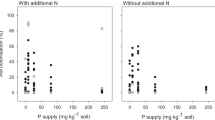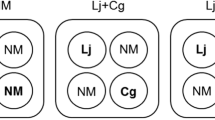Abstract
We investigated the effect of ectomycorrhizal colonization, charcoal and CO2 levels on the germination of seeds of Larix kaempferi and Pinus densiflora, and also their subsequent physiological activity and growth. The seeds were sown in brown forest soil or brown forest soil mixed with charcoal, at ambient CO2 (360 μmol mol−1) or elevated CO2 (720 μmol mol−1), with or without ectomycorrhiza. The proportions of both conifer seeds that germinated in forest soil mixed with charcoal were significantly greater than for seeds sown in forest soil grown at each CO2 level (P < 0.05; t-test). However, the ectomycorrhizal colonization rate of each species grown in brown forest soil mixed with charcoal was significantly lower than in forest soil at each CO2 treatment [CO2] (P < 0.01; t-test). The phosphorus concentrations in needles of each seedling colonized with ectomycorrhiza and grown in forest soil were greater than in nonectomycorrhizal seedlings at each CO2 level, especially for L. kaempferi seedlings (P < 0.05; t-test), but the concentrations in seedlings grown in brown forest soil mixed with charcoal were not increased at any CO2 level. Moreover, the maximum net photosynthetic rate of each seedling for light and CO2 saturation (P max) increased when the seedlings were grown with ectomycorrhiza at 720 μmol mol−1 [CO2]. Ectomycorrhizal colonization led to an increase in the stem diameter of each species grown in each soil treatment at each CO2 level. However, charcoal slowed the initial growth of both species of seedling, constraining ectomycorrhizal development. These results indicate that charcoal strongly assists seed germination and physiological activity.



Similar content being viewed by others
References
Allen MF (1991) The ecology of the mycorrhizae. Cambridge University Press, Cambridge, p 184
Amaranthus MP (1994) Mycorrhizas, forest disturbance and regeneration in the pacific northwestern United States. In: Read DJ, Lewis DH, Fitter AH, Alexander IJ (eds) Mycorrhizas in ecosystems. CAB International, Singapore, pp 202–207
Barnes BV, Zak DR, Denton SR, Spurr SH (1998) Forest ecology, 4th edn. Wiley, New York, p 774
Choi DS, Quoreshi AM, Maruyama Y, Jin HO, Koike T (2005) Effect of ectomycorrhizal infection on growth and photosynthetic characteristics of Pinus densiflora seedlings grown under elevated CO2 concentrations. Photosynthetica 43:223–229
Choi DS, Kayama M, Jin HO, Lee CH, Izuta T, Koike T (2006) Growth and photosynthetic responses of two pine species (Pinus koraiensis and P. rigida) planted in a polluted industrial region in Korea. Environ Pollut 139:421–432
Choi DS, Jin HO, Chung DJ, Sasa K, Koike T (2008) Growth and physiological activity in Larix kaempferi seedlings inoculated with ectomycorrhizae as affected by soil acidification. Trees Struct Funct 22:729–735
DeBano LF, Neary DG, Ffolliott PF (1998) Fire’s effects on ecosystems. Wiley, New York, p 333
Farrar JF, Williams ML (1991) Te effects of increased atmospheric carbon dioxide and temperature on carbon partitioning, source-sink relations and respiration. Plant Cell Environ 14:819–830
Hille M, Ouden J (2005) Charcoal and activated carbon as adsorbate of phytotoxic compounds—a comparative study. Oikos 108:202–207
Hytteborn H, Maslov AA, Nazimova DI, Rysin LP (2005) Boreal forests of Eurasia. In: Andersson F (ed) Ecosystems of the world: coniferous forests, vol 6. Elsevier, Amsterdam, pp 23–99
IPCC (2000) Land use, land-use change, and forestry. Cambridge University Press, New York, p 377
IPCC (2007) Climate change 2007: the physical science basis. Cambridge University Press, New York, p 996
Janos DP (1980) Vesicular-arbuscular mycorrhizae affect lowland tropical rain forest plant growth. Ecology 61:151–162
Janos DP (1996) Mycorrhizas, succession and the rehabilitation of deforested lands in the humid tropics. In: Frankland JC, Magan N, Gadd GM (eds) Fungi and environmental change. Cambridge University Press, Cambridge, pp 129–161
Kimmins JP (2003) Forest ecology: a foundation for sustainable forest management and environmental ethics in forestry, 3rd edn. Prentice-Hall, Upper Saddle River, p 611
Koike T, Yazaki K, Funada R, Kitao M, Maruyama Y, Takahashi K, Maximov TC, Ivanov BI (2000) Photosynthetic characteristics of Dahurian larch, Scotch pine and white birch seedlings native to eastern Siberia raised under elevated CO2. Eurasian J For Res 1:31–37
Lambers H, Chapin FSIII, Pons TL (1998) Plant physiological ecology. Springer-Verlag, New York, p 540
Makoto K (2005) Investigation of regeneration and vegetational recovery in the severely disturbed area by typhoon and fire. North For (Hoppo Ringyo) 57:265–268 (in Japanese)
Makoto K, Bruanin SV, Naumenko AY, Nemilostiv YP, Yoshida T, Satoh F, Sasa K, Koike T (2007a) Seed bed effects on seed germination of Picea jezoensis. Pinus sylvestris and Larix gmelinii after the fire—a case study in the Amur States, Far Eastern Russia. Trans Hokkaido Bra Jpn For Soc 55:23–25 (in Japanese)
Makoto K, Nemilostiv YP, Zyryanova OA, Kajimoto T, Matsumura Y, Yoshida T, Satoh F, Sasa K, Koike T (2007b) Regeneration after forest fire in mixed confer broad-leaved forests of the Amur region in Far East Russia: the relationship between species specific traits against fire and recent fire regimes. Eurasian J For Res 10:51–58
Nakamura Y, Krestov PV (2005) Coniferous forests of the temperate zone of Asia. In: Andersson F (ed) Ecosystems of the world: coniferous forests, vol 6. Elsevier, Amsterdam, pp 163–220
Nara K (2006) Ectomycorrhizal networks and seedling establishment during early primary succession. New Phytol 169:169–178
Qu L, Ji D, Shi F, Sasa K, Koike T (2005) Growth and photosynthetic performance of seedlings of two larch species grown in shaded conditions. Eurasian J For Res 8:43–51
Rouhier H, Read DJ (1998) Plant and fungal response to elevated atmospheric carbon dioxide in mycorrhizal seedlings of Pinus sylvestris. Environ Exp Bot 40:237–246
Rouhier H, Read DJ (1999) Plant and fungal response to elevated atmospheric CO2 in mycorrhizal seedlings of Betula pendula. Environ Exp Bot 42:231–241
Rutto KL, Mizutani F (2006) Effect of mycorrhizal inoculation and activated charcoal on growth and nutrition in peach (Prunus persica Batsch) seedlings treated with peach root-bark extracts. J Jpn Soc Hortic Sci 75:463–468
Simard SW, Perry DA, Jones MD, Myrold DD, Durall DM, Molina R (1997) Net transfer of carbon between ectomycorrhizal tree species in the field. Nature 388:579–582
Smith SE, Read DJ (2008) Mycorrhizal symbiosis, 3rd edn. Academic, New York, p 787
Thompson M, Walsh JN (1989) Handbook of inductively coupled plasma spectrometry, 2nd edn. Soil Science Society of America Inc., Madison, pp 159–165
Tissue DT, Thomas RB, Strain BR (1996) Growth and photosynthesis of loblolly pine (Pinus taeda) after exposure to elevated CO2 for 19 months in the field. Tree Physiol 16:49–59
Wardle DA, Zackrisson O, Nilson MC (1998) The charcoal effect in boreal forests: mechanisms and ecological consequences. Oecologia 115:419–426
Warnock DD, Lehmann J, Kuypern TW, Rilling MC (2007) Mycorrhizal responses to biochar in soil—concepts and mechanisms. Plant Soil 300:9–20
Acknowledgments
We deeply thank Prof. T. Koike of Hokkaido University for his proper guidance in this study and Prof. R. Funada, Prof. T. Izuta (Tokyo Univ. A. & T.) and Prof. H.O. Jin of KyungHee University for their support during the experiment. Thanks are also due to Dr. H. Toda (Tokyo Univ. A. & T.), Dr. Y. Maruyama, Dr. M. Kitao and Dr. H. Tobita (Forestry and Forest Products Research Institute; FFPRI) for their kind support and valuable comments about this study. This study was supported in part by the Improvement of Research Environment for Young Researchers project of MEXT Japan.
Author information
Authors and Affiliations
Corresponding author
Rights and permissions
About this article
Cite this article
Choi, D., Makoto, K., Quoreshi, A.M. et al. Seed germination and seedling physiology of Larix kaempferi and Pinus densiflora in seedbeds with charcoal and elevated CO2 . Landscape Ecol Eng 5, 107–113 (2009). https://doi.org/10.1007/s11355-009-0072-9
Received:
Revised:
Accepted:
Published:
Issue Date:
DOI: https://doi.org/10.1007/s11355-009-0072-9




